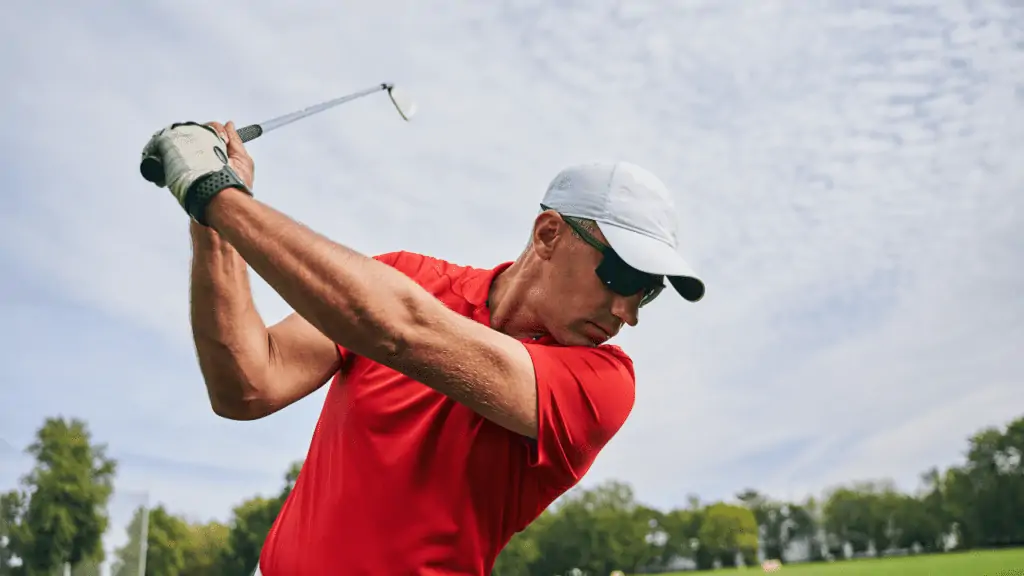Table of Contents
My buddy’s father recently complained that his joint pain is causing him to reduce rotation and lose distance. He even mentioned hanging up the clubs, but I am committed to growing the game, not diminishing it.
I explained that he should employ a closed coil golf swing for seniors.
In this post, I will relay the steps I shared with him for inducing this efficient swing. You will notice that I have laid out four simple steps to help you adopt and repeat the closed coil golf swing on every shot.
What Is A Closed Coil Golf Swing?
Golf coach, Dan Whittaker sums it up superbly by comparing a closed coil golf swing to the motion of your corkscrew when uncorking a fine Bordeaux blend.
The coil starts on your backswing as you shift most of your weight from your front leg to the back. In other words, you rotate in a clockwise direction.
At the top of your backswing, coil anti-clockwise and shift your weight back to your front leg. You will find that employing a closed coil swing helps you produce maximum rotational force without overswinging.
How Do You Coil A Golf Swing?
Step 1 – Standard Address
Your first objective is to address the ball, setup for your shot, and ensure the dimples are positioned correctly in your stance. Once you are comfortable with your setup, you proceed to phase two of the plan.
As a wise individual, you will know that you must apply downward pressure on a corkscrew for it to penetrate the oak. Otherwise, the screw rotates aimlessly at the top of the bottle, and your glass remains dry. The principle is the same in a closed coil golf swing for seniors.
Before each shot, ensure optimal stability to prevent your left foot from kicking out on the backswing and costing you balance.
Read Next: 5 Drills & Tips to Increase Golf Swing Speed for Seniors
Step 2 – Left Shoulder Down Into Your Back Heel
Golf coach, Mark Crossfield suggests that a closed coil golf swing demands that your left shoulder is aligned with your back heel at the top of your swing. In his demonstration, he shows how he swings down and around at the top, maximizing the coil of his upper body.
When Mark reaches the top, you will notice his left shoulder points down to his back heel. If left-handed, your right shoulder will align with your left heel. At this point, you should feel optimal tension in your gluteus maximus muscle, preparing you to release on the downswing.
Step 3 – Activate Back Leg Drive
When you start your downswing, your weight needs to shift forward, creating sufficient momentum for your club head to reach the impact zone. Drive the load on your back leg towards the front to keep your club head on path and increase power into impact.
You will see that you lose considerable power and control of the golf club when there is no rotation on the downswing.
Read Next: The Best Golf Club Distance Chart for Seniors: Men & Women
Step 4 – Square Your Clubface At Impact
Now that your golf club is en route to the ball, you have one final task to complete a closed coil golf swing. Keep your clubface square at contact to produce straight ball flight for increased accuracy.
In addition, it is vital that you clear your hips and commit to the shot-through impact for a consistent launch and carry distance. You will find that stabbing your shot prompts a lower launch and inaccurate flight for a short, wayward shot.
Following these four steps is the closed coil golf swing technique.
Drills For A Closed Coil Golf Swing

Down and Around
The down-and-around drill follows Crossfield’s advice and is a simple task to improve the shoulder aspect of your coil. I find it makes me more aware of my club positioning on the backswing to keep low and boost the coil.
Grab a mid iron and position it in your forearms, with the clubhead hanging over your right side and the butt on your left. If you are left-handed, do the opposite of what I say. Place a golf ball in the impact zone, and focus on getting the butt of the club pointing down at the ball instead of over it.
When you find that the butt is facing over the ball, your position is too high on the backswing, and you are generating insufficient coil. To execute this drill effectively, the butt of the club must point down to the toes on your trail foot while your shoulder aligns with your back heel.
No Left Shoe
Balance and traction are essential for a quality closed coil golf swing. If you find your lead foot kicking out on the backswing, you are likely losing balance and power on every shot. The no-shoes drill helps you master balance for superior traction on all strikes.
Remove the shoe on your lead foot, and hit five shots. You will feel when your weight is too far forward or back and see the result. With a better understanding of the impact of your stance and balance, hit five more shots, focusing on controlling your left foot and keeping it grounded.
Moving forward, a stable stance and optimal rotation will improve your power, ball speed, spin, and launch for greater length in your game.
Read Next: The Best Golf Club Distance Chart for Seniors: Men & Women
Final Thoughts: Closed Coil Golf Swing
There you have it. Now you know how to produce a closed coil golf swing for seniors. At the start of this post, I set out to determine whether this swing is good for seniors, and the answer is yes.
I find this motion makes it easier for golfers to produce sufficient rotation on the backswing and downswing without needing a full swing. Apart from amplified power, I noticed that it helps the average golfer keep the club on a path for improved accuracy from tee to green.
Frequently Asked Questions
What Is a closed coil golf swing?
A closed coil golf swing is a similar motion of your corkscrew when uncorking a fine wine. The closed coil golf swing starts on your backswing as you shift most of your weight from your front leg to the back.
How do you not sway a coil golf swing?
The best way to not sway a coil golf swing is to take your lead shoulder down and around on the backswing. You will see that this prompts your left shoulder to point down at your back heel, at the top of your backswing, creating a maximum coil.
When you fail to take your left shoulder down and around, you fail to optimize weight shift and instead sway. This motion causes you to lose power and sends your club off plane, resulting in a miss hit.
Should Senior Golfers use a closed stance?
Yes, senior golfers should use a closed stance, because it boosts shoulder and hip rotation for increased power in your swing. You will find that the closed coil swing helps you accelerate your club head and ball speed for father length in your long game.
Besides increasing your distance, the rotation in a closed coil swing helps you keep your club head on a path for a square face at contact. As a result, you increase your chances of generating a straighter golf shot.
How do you hit irons for seniors?
Seniors must hit the ball with their irons at the low point of their swing, creating increased compression for a high, long shot. In contrast to your driver or fairway woods, iron shots require the ball to sit slightly back in your stance.
If you are lining up a long iron shot, I recommend sitting the ball marginally forward of center. However, when you take out the mid and short irons, move the dimples back to the center of your stance. Finally, wedge shots are best struck when the ball is back of center with your short game stance.

